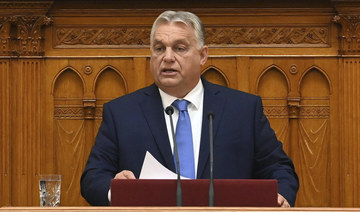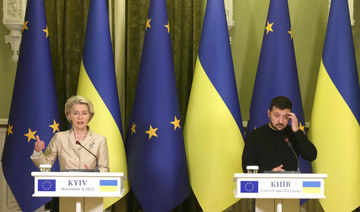WASHINGTON/TAIPEI: New security measures including stricter passenger screening take effect on Thursday on all US-bound flights to comply with government requirements designed to avoid an in-cabin ban on laptops, airlines said.
Airlines contacted by Reuters said the new measures could include short security interviews with passengers at check-in or the boarding gate, sparking concerns over flight delays and extended processing time.
They will affect 325,000 airline passengers on about 2,000 commercial flights arriving daily in the US, on 180 airlines from 280 airports in 105 countries.
The US announced the new rules in June to end its restrictions on carry-on electronic devices on planes coming from 10 airports in eight countries in the Middle East and North Africa in response to unspecified security threats.
Those restrictions were lifted in July, but the Trump administration said it could reimpose measures on a case by case basis if airlines and airports did not boost security.
European and US officials said at the time that airlines had 120 days to comply with the measures, including increased passenger screening. The 120-day deadline is Thursday. Airlines had until late July to expand explosive trace detection testing.
“We see this as a big issue for China Airlines,” Steve Chang, senior vice president of the Taiwanese firm told reporters on Wednesday, adding the airline was trying to consult with the American Institute in the country over the issue.
Korean Airlines, South Korea’s flagship carrier, also said it had a lot of concerns with the new measures.
“We are asking customers to show up at the airport early ... It’s just inconvenient for the passengers,” President and Chief Operating Officer Walter Cho told Reuters in Taipei.
Lufthansa Group said on Tuesday the measures would be in place by Thursday and travelers could face short interviews at check-in or at the gate.
Economy passengers on Lufthansa’s Swiss airline have been asked to check in at least 90 minutes before departure.
Cathay Pacific Airways Ltd. said it would suspend in-town check-in and self bag-drop services for passengers booked on direct flights to the US. The airline said passengers would also have short security interviews and it has advised travelers to arrive three hours before departure.
Singapore Airlines Ltd. said the security checks could include inspections of personal electronic devices as well as security questioning during check-in and boarding.
Airlines for America, a US trade group, said the changes “are complex security measures” but praised US officials for giving airlines flexibility in meeting the new rules.
Alexandre de Juniac, CEO of the International Air Transport Association, said the industry understoood security threats to aviation were made regularly but in this case the US government had not shared any specific dangers before changing the rules.
“What we have seen is very strange,” he told reporters in Taipei. “Unilateral measures announced without any prior consultation... That is something that is very concerning and disturbing.”
At their annual meeting in Taipei, Association of Asia Pacific Airlines (AAPA) members passed a resolution calling for security measures to be risk-based, outcome-focused and proportionate to the probable threat.
“Unilateral actions taken by individual goverments reacting to emerging threats may result in unneccessary disruption or lead to unintended safety consequences,” said the members.
AAPA includes most large Asian airlines but not mainland Chinese carriers.
“The risk is other countries make similar demands,” AAPA Director General Andrew Herdman said.
US authorities in June also increased security around aircraft and in passenger areas, and other places where travelers can be cleared by US officials before they depart.
A Transportation Security Administration (TSA) spokeswoman declined to discuss the specific changes but said “the United States continues to work with our partners to raise the baseline of global aviation security and keep the entire traveling public safe.”
The TSA said in July it was imposing new security rules requiring US domestic airline travelers to remove all electronic items larger than mobile phones such as tablets, e-readers and video game consoles from carry-on baggage for screening.
Airlines get ready for new US security rules from Thursday
Airlines get ready for new US security rules from Thursday

Over 3,000 Ukrainian inmates seek to join military

“We predicted this before the adoption of this law,” Deputy Minister of Justice Olena Vysotska said
KYIV: Thousands of Ukrainian inmates are seeking to join the military, Kyiv said Tuesday, following a decision by lawmakers enabling some categories of prisoners to join the armed forces.
The move echoes a policy in Russia, where tens of thousands of prisoners have been sent to Ukraine with the promise of amnesty and were killed in gruelling battles that produced few gains.
Ukraine is suffering critical ammunition and manpower shortages on the battlefield that have allowed Russian forces to advance on the eastern and northern front lines.
“This is more than 3,000 people. We predicted this before the adoption of this law,” Deputy Minister of Justice Olena Vysotska said, referring to the number of prisoners who have submitted applications to join the military.
She said authorities had identified 20,000 eligible prisoners and that of them, 4,500 had “expressed interest” in joining. She added that the figure was likely to fluctuate.
Only prisoners with fewer than three years left on their sentence can apply. Mobilized prisoners are granted parole rather than a pardon.
Among those not eligible to serve include those found guilty of sexual violence, killing two or more people, serious corruption and former high-ranking officials.
Russia has recruited prisoners to serve on the front lines since the first days of its invasion, initially offering presidential pardons for six months’ service.
EU states push for June start to Ukraine membership talks

- To actually begin the negotiations the bloc’s member states still have to sign off on a formal framework for the process
- At a meeting in Brussels, France’s EU affairs minister Jean-Noel Barrot called for “the effective opening of negotiations“
BRUSSELS: Several EU countries on Tuesday called for the bloc to start membership negotiations with Ukraine and Moldova in June, but Hungary threatened to throw a spanner in the works.
The 27-nation EU took the landmark step in December of agreeing to open talks on its war-torn neighbor — and fellow ex-Soviet state Moldova — joining the club.
But to actually begin the negotiations the bloc’s member states still have to sign off on a formal framework for the process, proposed in March by Brussels.
At a meeting in Brussels, France’s EU affairs minister Jean-Noel Barrot called for “the effective opening of negotiations” before Belgium’s rotating presidency concludes at the end of June.
That statement was echoed by other ministers — including from Ireland and Sweden.
The push to move Ukraine onto the next step in its quest for EU membership comes amid fears that Hungary, the friendliest country with Moscow in the bloc, could stall progress when it takes over the presidency after Belgium.
Budapest has been hostile to Kyiv’s bid to join, arguing that Ukraine is getting pushed ahead in the queue without meeting the required criteria.
“There can be no exception on the basis of political or ideological considerations,” Hungarian minister Zoltan Kovacs said.
“There is very little, if any, progress. Again, I can repeat to you that membership, approval should be a merit based process. No exceptions.”
Another possible hurdle could come from a new right-wing government being formed in The Netherlands opposed to any new enlargement of the bloc.
Ukraine applied to join the EU shortly after Russia launched all-out invasion in February 2022.
Starting the negotiations would put Ukraine still only at the start of what is likely to be a years-long process of reforms before it can finally become a member.
Philippine island boasts world’s largest concentration of unique mammals

- 93% of mammals in Luzon are found nowhere else
- Island has higher biological diversity than Galapagos
MANILA: Luzon may be known as the largest and most populous island of the Philippines, but it is also home to the greatest concentration of unique mammal species on Earth. Most of them are found nowhere else in the world.
The island, where the Philippine capital Manila is located, had never been connected to any continental land. Throughout the ages, this allowed the species that arrived there from the Asian mainland to evolve, diversify, and thrive in different habitats of its mountain ranges and peaks isolated by lowlands.
It is also one of the oldest islands, with geological research indicating that parts of it have been dry land areas continuously for some 27 million years.
“It’s a really old island. So, there’s time for rare events to take place. That’s a big part of it,” Dr. Lawrence Heaney, biologist and curator of mammals at the Field Museum in Chicago, told Arab News.
“There are no countries in continental Europe that have (this number of) unique species of mammals.”
Heaney is one of the first researchers to document the island’s diversity and has been leading American and Filipino scientists studying mammals in the Philippines since 1981.
His team’s 15-year study, which started in 2000, concluded that there were 56 species of mammals — not including bats — on the island, and 52 of them were endemic.
This means that 93 percent of Luzon’s non-flying mammals are found nowhere else, making it a biological treasure trove.
Luzon beats even the Galapagos islands, where each has been known for its diverse and unique array of wildlife.
“Luzon takes it another step further because there are isolated mountain ranges and isolated mountain peaks that are separated from all others by lowlands. They function as islands. Islands in the sky. Each one of those islands in the sky has its own unique set of species. Luzon island is made up of islands within the island,” Heaney said.
“What’s in the northern Sierra Madre, you know Cagayan province ... is very different from what’s in the mountains that are in Aurora province, because there’s an area of lowlands that separates those two different mountain chains. Then the mountains, the next set of mountains down also are separated by another low-lying area ... There are species of mammals that occur there that don’t live anywhere else in the world.”
Many of those mammals are tiny — the size of the house mouse. When most people think about mammal species, they usually imagine those on the larger part of the spectrum, like themselves.
“We think about water buffalo and horses and lions and tigers and bears,” Heaney said. “There are actually very few large mammals, overwhelmingly, most mammals are small, less than 200 grams ... Not surprisingly, given that, most of the things that we have discovered that were previously unknown are small.”
Mariano Roy Duya, associate professor at the University of the Philippines’ Institute of Biology, who has been working with Heaney, told Arab News that 28 out of the 56 mammal species identified in Luzon were rodents.
Two of them — the Banahaw shrew rat and the Banahaw tree mouse — were endemic to Mt. Banahaw, which is only 100 km from Manila.
The Banahaw shrew-rat has a long, slender snout, a short tail, and weighs 150 grams, while the Banahaw tree mouse is the smallest member of the cloud rat family at 15.5 grams, and navigates tree branches and vines.
Their habitat is now protected due to the efforts of the Biodiversity Conservation Society of the Philippines, a group that was created thanks to the work of scientists like Heaney and Duya, who now serves as its vice president.
The society is an organization that the Philippine Department of Environment and Natural Resources consults on the country’s conservation efforts.
Some 20 percent of the species Heaney, Duya, and other researchers studied during their long Luzon project are vulnerable, endangered, or critically endangered due to habitat loss, hunting, and illegal wildlife trade.
“(These include) deer, warty pigs, cloud rats, flying foxes, cave-dwelling bats, and civets,” Duya said.
“According to the hunters we meet in the forest, these animals are becoming hard to find.”
Most of the threats to Luzon’s wildlife were observed in lowland forests, which are usually lost to human development, overlogging, conversion to agricultural fields, and trafficking.
“Close monitoring of illegal wildlife trade and regular enforcement activities should be a priority,” Duya said.
“Securing these forests, as well as forest fragments, will provide refuge to many of these endemic faunae.”
Germany: ICC asking for arrest warrants for Hamas leaders is logical

- “The accusations of the chief prosecutor are serious and must be substantiated,” said the spokesperson
BERLIN: A request by the International Criminal Court (ICC) for arrest warrants for Hamas leaders is logical and no comparisons can be made with Israel’s prime minister and defense minister, for whom warrants are also being sought, a German government spokesperson said.
“The accusations of the chief prosecutor are serious and must be substantiated,” said the spokesperson on Tuesday. He added that Germany assumed Israel’s democratic system and rule of law with a strong, independent judiciary would be taken into account by judges deciding whether to issue the warrants.
Indonesia, UAE to build mangrove research center in Bali

- Countries are part of Mangrove Alliance for Climate launched at COP27
- Southeast Asian country is home to about 23% of global mangrove ecosystems
JAKARTA: Indonesia and the UAE are collaborating to build a mangrove research center in Bali as part of a partnership to promote nature-based solutions to climate change.
The Southeast Asian country is home to about 23 percent of all mangrove ecosystems in the world. In the face of climate change, mangroves are essential in protecting coastal communities against rising sea levels and capturing massive amounts of emissions and greenhouse gases from the atmosphere.
At COP27, the 2022 UN climate summit held in Egypt, the archipelagic country partnered with the UAE to launch the Mangrove Alliance for Climate, an initiative focused on nature-based efforts to address issues related to climate change. It was later joined by dozens of other countries, including Australia and India.
As part of that cooperation, the two countries will start building an international mangrove research center in Bali, following a groundbreaking ceremony held over the weekend.
“This institution represents one of the UAE’s most important contributions in its partnership with Indonesia to promote nature-based solutions to address impacts of climate change in the two countries and in the world,” UAE Minister of Climate Change and Environment Dr. Amna bint Abdullah Al-Dahak said in a statement on Tuesday.
“Taking into consideration the significant decline of mangrove forests in the world, the UAE is aware that losing even more mangrove trees will worsen the impacts of climate change … this research center will work to create solutions.”
Al-Dahak attended the ceremony alongside Suhail Mohamed Al-Mazrouei, a special envoy of the UAE president, and Luhut Binsar Pandjaitan, Indonesia’s coordinating minister of maritime affairs and investment.
According to Indonesia’s Maritime Affairs and Investment Ministry, the center will focus on conducting research, conservation and providing education related to mangroves, particularly on harnessing biotechnology and innovative uses of artificial intelligence to identify and restore mangrove ecosystems.
“I’m proudly announcing that the International Mangrove Research Center will be built in a strategic location in Bali, which has already shown its success in preserving mangrove ecosystems and will garner international attention,” Pandjaitan said.
Indonesia has made mangrove planting a key feature in the international events that it hosts, including the Group of 20 Meeting in 2022 and the 10th World Water Forum, which runs until May 25. The research center will be built within the Ngurah Rai Forest Park, Bali’s largest mangrove conservation area covering about 1,300 hectares.


















